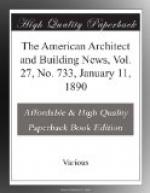feature, and that is, that they are protecting themselves
against unwarranted and unexpected advances in the
cost of their raw material by making purchases for
future requirements, ranging from three to six months.
Users of cotton and wool are largely doing this; so
are users of iron ore and iron and steel, as well as
users of lumber, stone, cement and building material
generally. This general policy of providing for
legitimate future requirements is one of those instincts
which safely guide the commercial world out of danger
into safety. One fruitful source of panics in
former periods of activity was the failure of consuming
interests to supply themselves with raw material to
complete their contracts. The business world has
learned wisdom from its experience, and is now quietly
turning a corner and wheeling into line safely early
in 1890. The tanning interests of the United
States have pursued this course in their limited field.
The boot and shoe manufacturers, if they have not
bought largely of raw material, have, at least, taken
such steps as will guarantee them against a sudden
advance. The clothing manufacturers have wisely
purchased for their future wants; in fact, in almost
every avenue of activity this policy has been pursued.
The users of Lake ore have already bought five and
one-half millions of the seven or eight million tons
of ore they will want this year. The users of
steel blooms and billets have bought so far ahead
that manufacturers are now declining to make further
contracts, excepting for very strong reasons.
The Southern pig-iron makers are debating with themselves
whether they will accept orders for pig-iron to be
delivered next summer or wait a few months. Scores
of illustrations of this sort could be enumerated.
In many quarters this policy is believed to be an
unwise one. Experience has shown it to be a safe
one.
The iron industry, as a whole, is on a very permanent
foundation. Manufacturers are hurrying to complete
new works; lumber manufacturers, especially throughout
the South, are stimulated to the greatest exertion
by two new causes: First, a strong demand throughout
the North for the superior lumber-mill products of
the South; and second, a wonderful expansion of local
demand in the South arising from the new industries
there. The makers of nearly all kinds of machinery
are busy with new work, fully one-half of which is
for delivery in the new Southern or Western States.
The manufacturers of steam-pumps, the manufacturers
of appliances for new fuel-gas processes, the builders
of heavy machinery for steam and electrical purposes,
the manufacturers of hoisting-machinery and of machinery
for mining purposes, as well as of machinery for general
shop-use, have been booking more business since the
1st of October than their present shop-capacity will
allow them to execute. Consequently, a general
system of enlargement is in progress. Contracts
have been lately given out for the construction of




